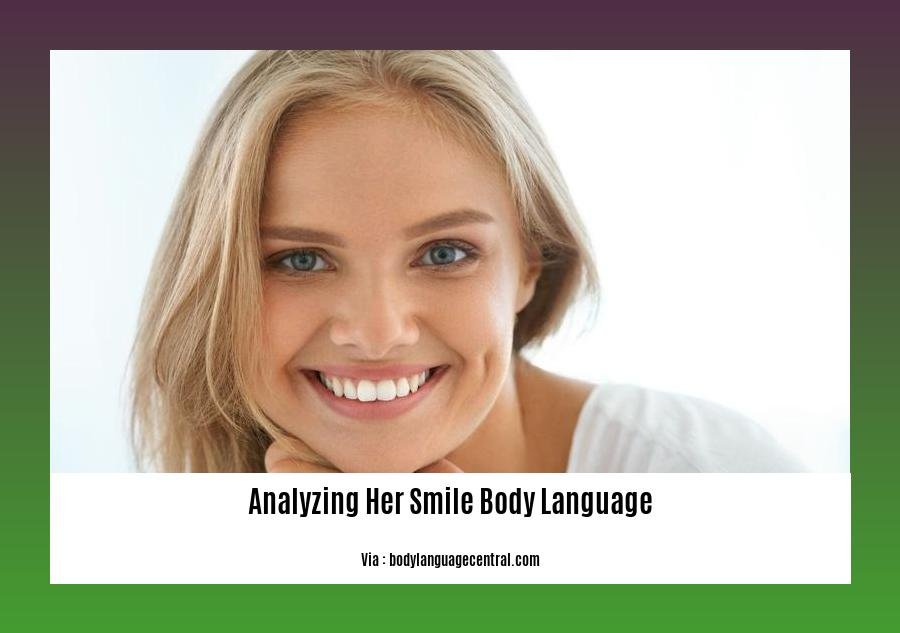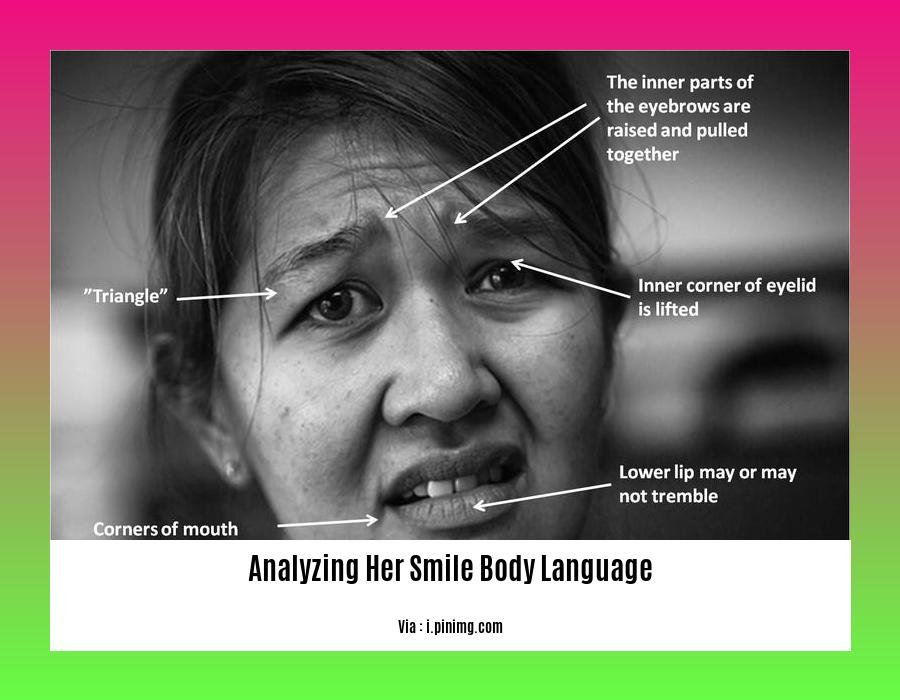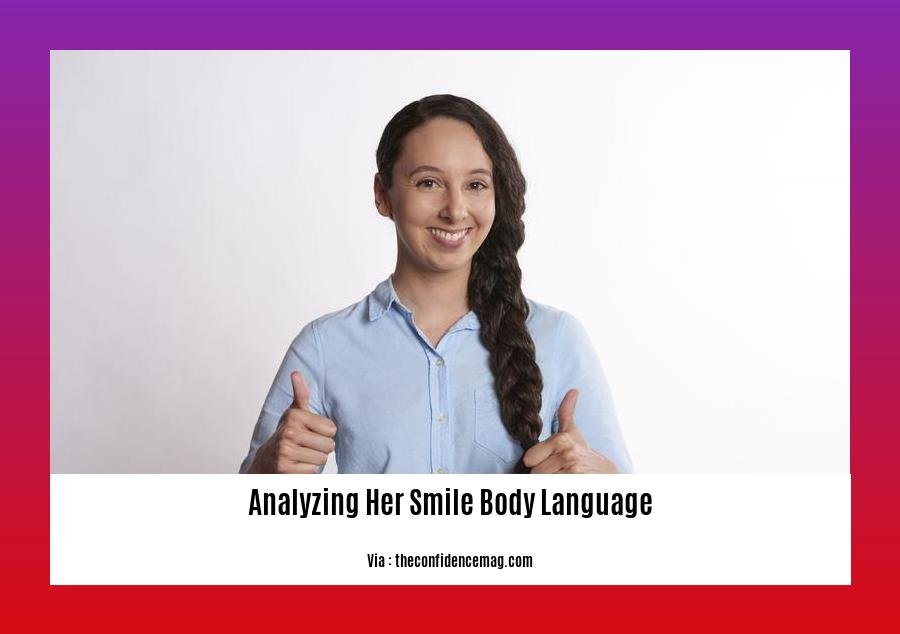Embark on a journey of discovery with our comprehensive guide, “Analyzing Her Smile Body Language: Unveiling Hidden Truths.” Dive into the intricate world of nonverbal communication and unlock the secrets behind the enigmatic smile. As we delve into the subtle nuances of facial expressions, gestures, and posture, you’ll gain an extraordinary ability to decipher the hidden emotions beneath the surface. Prepare to master the art of interpreting smiles, unraveling the complex language of body language, and forging deeper connections through effective communication.
Key Takeaways:

- Genuine smiles involve both mouth and eye movement.
- Insincere smiles often lack eye involvement.
- Smirks may indicate uncertainty or dislike when following negative expressions.
- Eye contact during smiling can suggest attraction, especially with prolonged glances or head tilts.
- Eye movements reveal emotions and thoughts.
- Facial expressions convey emotions like happiness, sadness, and anger.
- Gestures express emotions and convey messages.
Analyzing Her Smile Body Language
When it comes to analyzing her smile body language, it’s essential to look beyond the mere shape of her mouth. A genuine smile, a telltale sign of joy and warmth, involves the engagement of both the mouth and eyes. Pay attention to the crinkling around the eyes, known as crow’s feet, which indicates a sincere expression.
In contrast, an insincere smile often lacks the eye involvement. It may appear plastered on, with little to no movement in the eyes. This type of smile can be a polite gesture or a mask concealing true emotions.
Subtle Gestures and Eye Contact
Smirks, often fleeting expressions, can signal uncertainty, disdain, or dislike, especially when they follow an expression of displeasure or contempt. Observe the direction of her gaze. Eye contact, particularly when sustained or accompanied by a head tilt, can suggest attraction or interest.
Beyond Smiles: Exploring Facial Expressions
Smiles are just one piece of the body language puzzle. Facial expressions, as a whole, convey a wide range of emotions, from happiness and sadness to anger and fear. When analyzing her smile body language, also take note of other facial cues, such as raised eyebrows, furrowed brows, or pursed lips, as they can provide additional insights into her emotional state.
Understanding Body Language in Context
It’s crucial to remember that body language, including smiles, should not be interpreted in isolation. Consider the context of the situation, her verbal communication, and any other relevant factors. By combining all these elements, you can gain a more comprehensive understanding of her true feelings and intentions.
Discover the hidden meaning behind her laughter and smile body language. her laugh and smile body language meaning
Unlock the secrets of what her laugh truly conveys. what her laugh is really saying
Explore the nuances and meanings behind different smiles displayed by women. the meaning behind different smiles in women
Contextual Considerations
Body language, as we established earlier, forms the bedrock of effective communication, conveying up to 65% of our messages without uttering a single word. However, the interpretation of these nonverbal cues is far from straightforward and requires careful consideration of the contextual factors surrounding an interaction.
Simply put, the same smile can convey a wealth of different emotions depending on the setting, the relationship between the participants, and the verbal cues that accompany it. To truly understand the meaning behind a smile, we must delve into the context in which it is displayed.
Key Takeaways:
- Context is paramount in interpreting body language, especially smiles.
- A smile in a professional setting may indicate politeness or conformity, while a smile in a romantic context may signal attraction.
- Facial expressions, gestures, and body language should be interpreted in conjunction with the spoken words and the overall environment.
Citation:
Interpreting Body Language Cues: A Guide to Understanding Nonverbal Signals
Key Takeaways:
- Facial expressions, gestures, and posture convey up to 65% of communication.
- Microexpressions lasting a fraction of a second reveal hidden emotions.
- Eyebrow movements play a key role in expressing surprise and fear.
- Genuine smiles involve both the eyes and mouth, while insincere smiles may be forced and lack eye engagement.
- Body language signals can be used to assess a person’s confidence, personality, and intentions.
Unveiling Nonverbal Truths
Facial Expressions:
Our faces are a window to our emotions. Universal expressions, such as the smile, frown, and furrowed brows, convey our inner feelings. Subtle cues like microexpressions can even reveal fleeting emotions we try to conceal.
Gestures and Postures:
Body movements and postures provide valuable insights. Crossed arms may indicate defensiveness, while open and uncrossed limbs suggest receptiveness. Nervousness is often expressed through fidgeting or nail-biting.
Body Distance and Orientation:
How close we stand to someone and the direction we face send intentional signals. Intimate proximity suggests familiarity, while maintaining a distance can indicate formality or discomfort. Turning our bodies away from someone can convey disinterest or rejection.
Eye Contact and Gaze:
Eye contact is crucial for communication. Sustained eye contact can build rapport, while evasive or shifty eyes may indicate discomfort or deception. The direction of our gaze can also reveal what we’re focused on or interested in.
Tips for Effective Interpretation:
- Consider context: Body language cues should be interpreted in conjunction with verbal communication and situational factors.
- Look for consistency: Multiple nonverbal cues that support the same message are more reliable than isolated signals.
- Be aware of cultural differences: Body language can vary across cultures, so it’s important to understand the norms of different societies.
Conclusion:
Interpreting body language cues is a powerful skill that enables us to better understand others and ourselves. By deciphering the nonverbal signals our bodies send, we can improve our communication, build stronger relationships, and navigate social situations with greater confidence.
Citation:
Effective Communication Through Understanding Smiles
Key Takeaways:
- True smiles involve both mouth and eye movement.
- Insincere smiles lack eye engagement.
- Partial smiles may indicate uncertainty or discomfort.
- Body language cues include facial expressions, eye contact, gestures, posture, and personal space.
- Understanding smiles enhances communication and fosters deeper connections.
Understanding smiles is crucial for Effective Communication Through Understanding Smiles. Smiles are not merely fleeting expressions; they convey a wealth of information about a person’s emotions, thoughts, and intentions. By deciphering the nuances of a smile, we can gain valuable insights into what someone is truly communicating.
Just like words, smiles can be genuine or insincere. A genuine smile, often referred to as a Duchenne smile, engages both the mouth and the eyes. The corners of the mouth turn up, and the eyes narrow and wrinkle at the corners, creating crow’s feet. This type of smile reflects true happiness or amusement.
In contrast, an insincere smile, or social smile, involves only the mouth movement. The corners of the mouth may curl up, but the eyes remain expressionless. This smile is often used to conform socially or mask discomfort. Partial smiles, where only one side of the mouth moves, can also indicate uncertainty, disdain, or dislike.
Beyond the mouth, body language provides a comprehensive context for interpreting smiles. Eye contact, for instance, plays a significant role. Sustained eye contact while smiling suggests attraction or interest, while a head tilt can further amplify these signals. Facial expressions, such as raised eyebrows, furrowed brows, and pursed lips, complement smiles and offer additional cues about a person’s emotions.
Understanding smiles requires considering the situation and context. A smile in a professional setting may have a different meaning than one during a friendly conversation. Observing gestures, posture, and personal space can provide further context for interpreting a smile’s intent.
Mastering the art of understanding smiles empowers us to communicate more effectively and build stronger relationships. By deciphering the subtle cues conveyed through smiles, we can navigate social interactions with confidence and authenticity.
Citation:
- Psychology Today: What a Smile Reveals About You and Others











